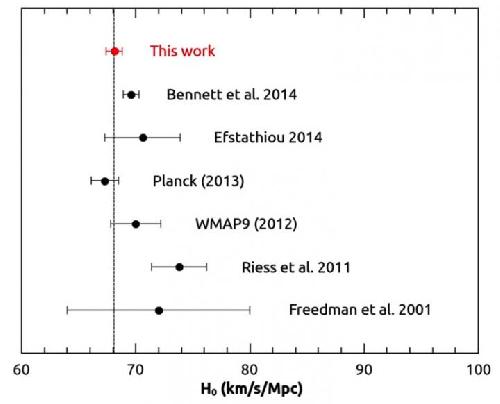In 1920's Edwin Hubble, an American astronomer, showed that the recessional velocity of a galaxy increases with its distance from the earth, known as Hubble's law. Hubble's law is taken as the first observational basis for the expansion of the Universe, and provides strong evidence for the Big Bang model. The value of the expansion rate is called the Hubble constant. Hubble constant is a critical parameter in cosmology and the measurement of Hubble constant is a key task for the astrophysicists and cosmologists. Recently a Chinese team leaded by Prof. Qing-Guo Huang from the institute of theoretical physics at Chinese Academy of Sciences proposed to utilize the Baryon Acoustic Oscillation (BAO) datasets to accurately determine the Hubble constant. Their work, entitled "An accurate determination of the Hubble constant from baryon acoustic oscillation datasets", was published in Sci China-Phys Mech Astron 2015, Vol. 58 No. 9.
The Universe is expanding. One may immediately ask what is the expansion rate of the Universe, i.e. the value of the Hubble constant. Under the framework of general relativity proposed by Albert Einstein one hundred years ago, the total energy density of our Universe can be also determined by the Hubble constant because our Universe is spatially flat.
Usually, according to the Hubble's law, the value of the Hubble constant is estimated by measuring the redshifts of distant galaxies and determining the distances to the same galaxies. For most of the second half of the 20th century, the Hubble constant was estimated to be between 50 and 100 km/s/Mpc. Until Hubble Space Telescope and its Key project released their results, the Hubble constant was measured accurately at the first time. This result was significantly improved by Nobel laureate Adam Riess and his collaborators in 2011.
 Comparison of different measurements of Hubble constant. Credit: ©Science China Press
Comparison of different measurements of Hubble constant. Credit: ©Science China Press
BAO is considered as a standard ruler in the Universe and is used to explore the expansion history of the Universe. However, usually ones thought that BAO data alone could not be used to determine the Hubble constant. It is true for the low-redshift BAO datasets alone because of the degeneracy. But, "The combination of the low and high-redshift BAO data can be used to precisely determine the Hubble constant", said the authors. In addition, they found that the low-redshift anisotropic BAO alone could be used to precisely determine the Hubble constant as well. Combining both the isotropic and anisotropic BAO datasets, they achieved a determination of the Hubble constant with around 1.3% precision! However, their result is relatively low compared to that obtained by Riess et al..
On the other hand, the Hubble constant can be also determined by the anisotropies of Cosmic Microwave Background, for example the data from Planck satellite, indirectly. In the cosmological constant and cold dark matter model, the data released by Planck satellite in 2013 imply that the Hubble constant is also lower than that obtained by Riess et al., but consistent with that obtained by this Chinese team. The comparison of different Hubble constant measurements shows up in Figure 1.
Now the result obtained by Riess et al. is questioned. For example, G. Efstathiou reanalyzed the Riess et al. Cepheid data. Based on the revised geometric maser distance to NGC 4258, he found that the Hubble constant was consistent with both Planck satellite and BAO datasets.
It is recognized that an accurate measurement of the Hubble constant has potential to reveal exotic new physics, for example, a time-varying dark energy, additional relativisitic particles, or neutrino mass. The Chinese team leaded by Prof. Qing-Guo Huang made an important contribution to the measurement of the Hubble constant.
source: Science China Press